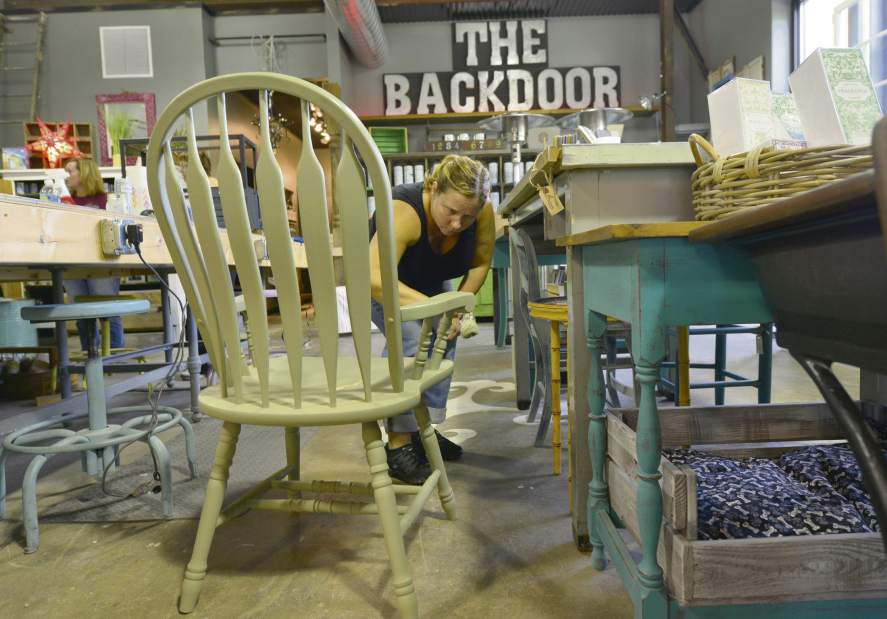By Kellie B. Gormly
The Pittsburgh Tribune-Review.
Laura Glatz, owner of a Wexford paint store, says that painting at home can be a risky job, with the fumes potentially sickening people. But many devotees are swearing by the environmentally friendly chalk paint by Annie Sloan, which is gaining a following here and beyond.
Glatz’s store — The Backdoor Furnishings, off of Perry Highway — is a designated “stockist” who has undergone professional training and continuing education for the water-based, lead-free chalk paint. The paint is relatively odorless and has very low content of volatile organic compounds (VOCs). It is sealed with a special Annie Sloan wax.
“People don’t want to paint indoors with something that is going to be harmful in any way,” Glatz says.
Although The Backdoor Furnishings sells other painting products — like the General Finishes line — the major bulk of the business comes from the chalk paint, which even pregnant women are comfortable using, Glatz says.
The store offers frequent workshops teaching people to use the chalk paint for home projects. The two rotating workshops are BYOP — “Bring Your Own Piece,” where participants bring small pieces of furniture and other items to paint — and “Kitchen Cabinet,” where people learn how to reface their existing cabinets in the kitchen, bathroom or laundry room by bringing in two door fronts. Learning how to do this yourself could save thousands of dollars, Glatz says.
“Chalk paint is a little bit different than a latex paint,” says Glatz, 48, of Mars. “We teach them how to apply the paint and distress the furniture.
“Especially for the ‘Kitchen Cabinet’ workshops, there is a technique to get that smooth finish that you want, and you need to make sure you’re doing it properly,” says Glatz, who previously worked in the energy industry.
The Backdoor Furnishings offers an Open Studio for people who have taken the BYOP class and want to take it from there, painting on their own at the store.
Lisa Vescio of Cranberry attended a recent BYOP workshop with an oak captain chair, and says she “did it from beginning to end.” She used a gray shade, distressed the wood, and finished with the wax.
“I love it,” Vescio says. “It’s beautiful.”
“I’ve never painted furniture before, so it was great to go and learn the technique of painting it and distressing it,” she says. “It was a whole new experience for me. I definitely would recommend it.”
Made out of organic pigments, Annie Sloan’s paint, which comes in more than 30 colors, can be applied to most surfaces and rarely requires any prep or sanding. The paint gets its name from the chalky consistency that you mostly see when distressing wood, Glatz says.
“If you have a stained piece of furniture, you can paint right over the stain and you don’t have to prep,” she says.
British artist and entrepreneur Annie Sloan created the chalk paint, her own brand of decorative paint, in 1990, according to the Sloan website. The chalk paint gained international popularity. Now, 25 years later, Sloan sells the chalk paint exclusively through more than 1,400 independent stockists around the world.
Sloan has written 20 books, including the new “Annie Sloan’s Chalk Paint Workbook: A Practical Guide to Mixing Color and Making Style Choices” (Ryland Peters & Small, $19.95).
The chalk paint is applied with a natural-bristle brush onto the objects, like kitchen cabinets or furniture and dries in five to 10 minutes. Then, the paint is sealed with wax. The final look has a matte finish.
“It gives it kind of that antique look,” Glatz says.
Susan Yanosick of Cecil recently became a chalk-paint devotee.
“I just love it,” she says. “I just like the way it goes on, how you can put it on top of anything, any surface.”
Chris Zrebiec, of Franklin Park, has been using the chalk paint for a few years.
“Amazing,” she says. “It’s so easy to work it.”














































































































































































































































































































































































